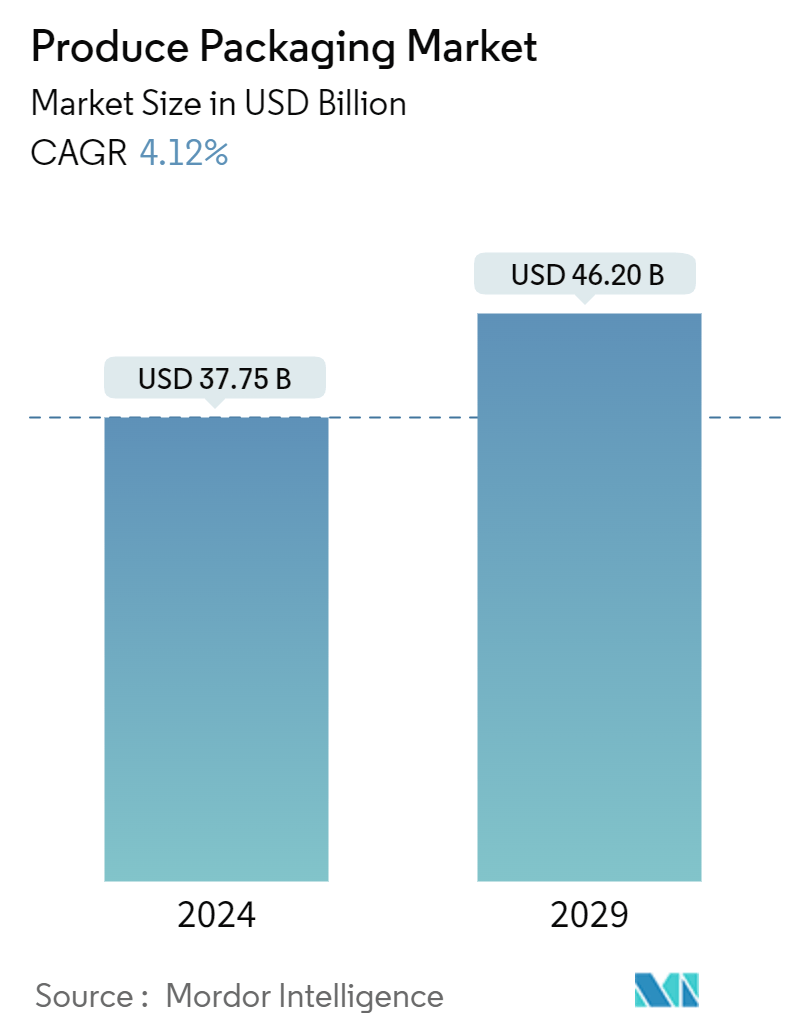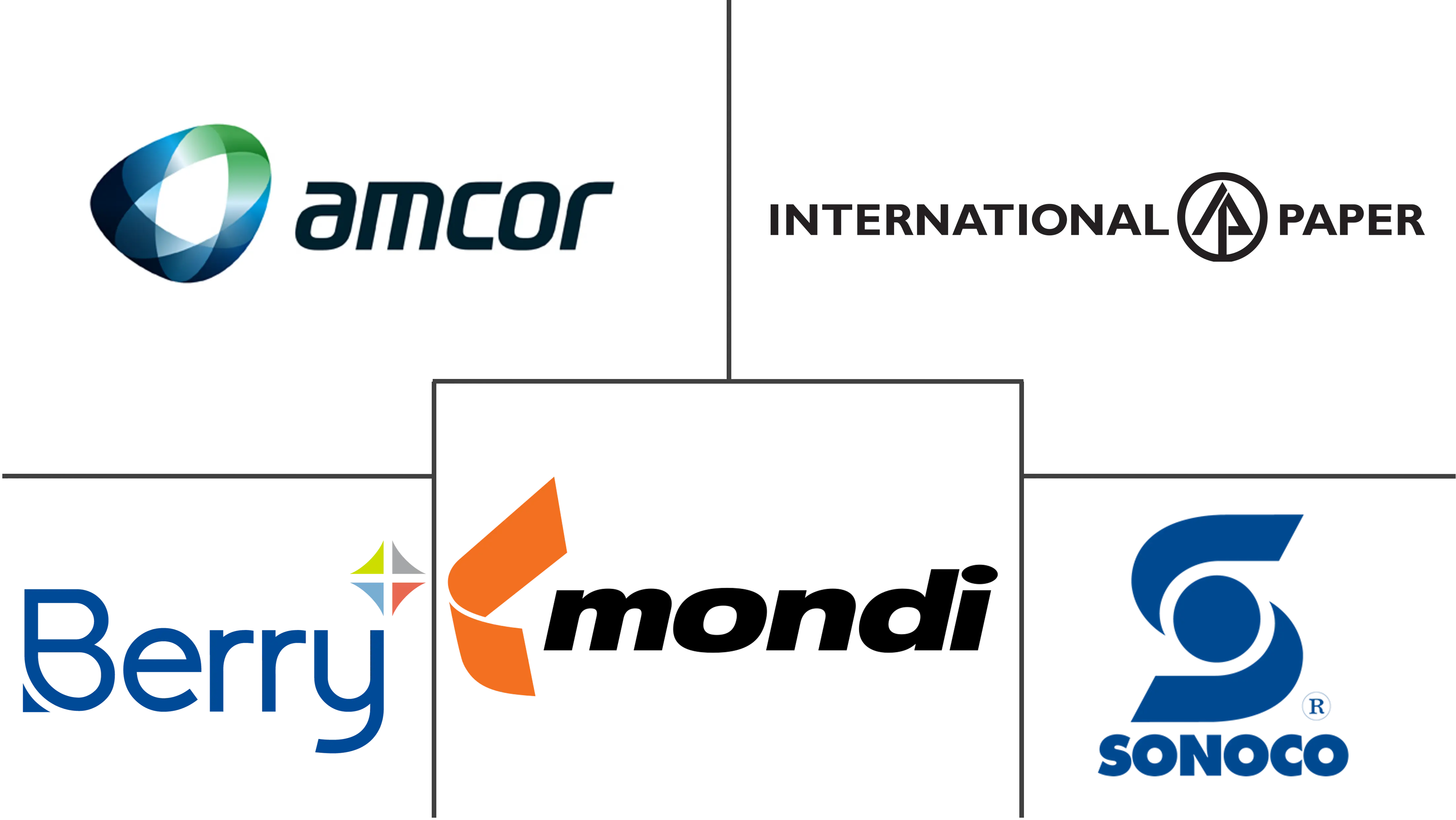Market Size of Produce Packaging Industry

| Study Period | 2019 - 2029 |
| Market Size (2024) | USD 37.75 Billion |
| Market Size (2029) | USD 46.20 Billion |
| CAGR (2024 - 2029) | 4.12 % |
| Fastest Growing Market | North America |
| Largest Market | Asia-Pacific |
| Market Concentration | Low |
Major Players
*Disclaimer: Major Players sorted in no particular order |
Produce Packaging Market Analysis
The Produce Packaging Market size is estimated at USD 37.75 billion in 2024, and is expected to reach USD 46.20 billion by 2029, growing at a CAGR of 4.12% during the forecast period (2024-2029).
Produce packaging ensures appropriate packaging for fresh vegetables and fruits. The growing demand for fresh fruits and organic products influences the demand for produce packaging.
- Produce packaging refers to packaging for fresh produce using various materials to protect it from physical damage. Packaging plays a pivotal role in lengthening a product’s shelf life by preserving valuable nutrients of the produce and retaining its freshness. Growing demand for ready-to-eat meals drives the produce packaging market for fresh fruits or pre-cooked vegetables.
- The growing investment in technology for produce packaging drives market growth. Companies such as Point Five Packaging (a United States-based company) use modified atmosphere packaging (MAP) technology, which decreases the oxidation process for fresh produce, keeping them from degrading as quickly as possible to extend shelf life. Additionally, technology significantly reduces the risk of contamination from environmental factors, including chemicals, moisture, and ultraviolet (UV) light.
- Suitable packaging is crucial to obtain optimal shelf-life and minimize physical damage to fresh produce. Cardboard is the most common type of packaging used. However, it also requires additional internal packaging materials, such as tissue wrapping, cups, and pads.
- Many companies in the market are aiming to improve the shelf life of fresh produce by using corrugated packaging. For instance, in January 2024, Cascades Inc., a Canadian company, launched new produce basket packaging designs made from 100% recycled fiber, which aligns with the company's circular economy approach. The new packaging line features a corrugated basket that prevents products from falling and keeps the fruits and vegetables intact throughout transportation and storage.
- The use of plastic containers for produce packaging can negatively impact the environment. Many retailers provide single-use plastic packaging for fruits and vegetables that cannot be recycled. Additionally, the use of plastic bags does not necessarily protect vegetables or fruits from being bruised, thus restraining the demand for plastic bags. In addition, several governments are banning single-use plastic bags. In August 2023, France announced the ban on plastic packaging for fresh fruits and vegetables to reduce plastic waste and its impact on the environment, which can impact the market’s growth.
Produce Packaging Industry Segmentation
The produce packaging includes various packaging material types such as plastic containers, corrugated boxes, bags and pouches, lidding films and laminates, and trays that are used and assembled to bundle, pack, label, or sleeve fresh produce (fruits and vegetables). Produce packaging offers numerous benefits for fresh produce, such as protection from physical damage, prevention of contamination, labeling and marketing potential, improved shelf life, and reduction in food wastage.
The produce packaging market is segmented by packaging material type (plastic containers, corrugated boxes, bags and pouches, lidding films and laminates, and trays), application (fruits and vegetables), and geography (North America, Europe, Asia-Pacific, Middle East and Africa, and Latin America). The market sizes and forecasts are provided in terms of value (USD) for all the above segments.
| By Packaging Material Type | |
| Plastic Containers | |
| Corrugated Boxes | |
| Bags and Pouches | |
| Film Lidding and Laminates | |
| Trays |
| By Application | |
| Fruits | |
| Vegetables |
| By Geography | |
| North America | |
| Europe | |
| Asia-Pacific | |
| Middle East and Africa | |
| Latin America |
Produce Packaging Market Size Summary
The produce packaging market is poised for significant growth, driven by the increasing consumer demand for fresh and healthy food options. This demand is further fueled by a shift in consumer behavior towards sustainability and hygiene, particularly in the wake of the COVID-19 pandemic. The market is witnessing advancements in packaging technology and materials, which not only enhance the shelf life of fruits and vegetables but also make them more appealing to consumers. Innovations such as eco-friendly materials, interactive packaging, and UV protection are becoming prevalent. The use of corrugated packaging, known for its strength and resistance, is gaining traction as a viable alternative to plastic, with research highlighting its potential in preserving produce freshness. The market is characterized by high competition and a focus on sustainable practices, with companies expanding their offerings and forming strategic partnerships to meet the evolving consumer needs.
Regionally, the Asia Pacific is emerging as a significant market due to its growing demand for fresh produce packaging, driven by factors such as population growth, rising disposable incomes, and increased health awareness. The region is also a hub for research and innovation in packaging solutions, with companies and institutions collaborating to develop advanced materials. The produce packaging market is marked by a high level of competitive rivalry, with firms seeking to gain a sustainable advantage through innovation in design and technology. The market's growth is supported by strategic acquisitions and collaborations, as seen in recent developments by key players like Berry Global and Smurfit Kappa. Overall, the market is expected to continue its upward trajectory, with a focus on sustainability and efficiency in packaging solutions.
Produce Packaging Market Size - Table of Contents
-
1. MARKET INSIGHTS
-
1.1 Market Overview
-
1.2 Industry Value Chain Analysis
-
1.3 Industry Attractiveness - Porter's Five Forces Analysis
-
1.3.1 Threat of New Entrants
-
1.3.2 Bargaining Power of Buyers
-
1.3.3 Bargaining Power of Suppliers
-
1.3.4 Threat of Substitute Products
-
1.3.5 Intensity of Competitive Rivalry
-
-
1.4 Impact of COVID-19 on the Market
-
-
2. MARKET SEGMENTATION
-
2.1 By Packaging Material Type
-
2.1.1 Plastic Containers
-
2.1.2 Corrugated Boxes
-
2.1.3 Bags and Pouches
-
2.1.4 Film Lidding and Laminates
-
2.1.5 Trays
-
-
2.2 By Application
-
2.2.1 Fruits
-
2.2.2 Vegetables
-
-
2.3 By Geography
-
2.3.1 North America
-
2.3.2 Europe
-
2.3.3 Asia-Pacific
-
2.3.4 Middle East and Africa
-
2.3.5 Latin America
-
-
Produce Packaging Market Size FAQs
How big is the Produce Packaging Market?
The Produce Packaging Market size is expected to reach USD 37.75 billion in 2024 and grow at a CAGR of 4.12% to reach USD 46.20 billion by 2029.
What is the current Produce Packaging Market size?
In 2024, the Produce Packaging Market size is expected to reach USD 37.75 billion.

